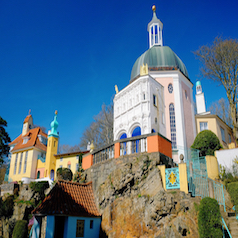Built Like Cake
By Fleur Chattillon
When is a building not actually a building? For that matter when is a cake not cake? When they are a cake-building? Silly we know, but actually, this really does exist. And no it’s not cake sized but building-sized, Find out more in Built Like Cake here

When we see a wedding cake in the middle of the forest we do not necessarily think ‘Hey that looks like a pastry office’. So what is it then? And what would be its purpose? Well in this case there is non-other than a beautiful, decorative or even funny building. In architectural terms, people call this phenomenon a Folly. This one was built like cake.
If you literally translate the meaning of ‘Folly’ its meaning is a fool, foolishness, impracticality or stupidity. So that is why these unique-looking buildings and sculptures with no functions are called follies.
But why on earth do they exist if they don’t have any purpose other than be fun and decorate a park or garden? Well, they first gained popularity in England during the 18th and early 19th centuries when landscape design and architecture were dominated by the tenets of romanticism. Depending on the designer’s taste or the command of the customer a Folly could come in a lot of different shapes and sizes.

Hameau de la Reine by Raúl Alejandro Rodríguez
An example of a famous and big project of Folly was an entire village declared by no one less than Marie-Antoinette, the queen of the Sun King Louis 16th. She began constructing charming Follies in her Trianon garden: a classical temple, a carousel, and a fake mountain. For the last addition to her garden, she asked her architect, Richard Mique, to create a peasant village, or a Hameau, (French for hamlet), on the outskirts of her property. A play village for her delights.
The popularity of Follies originated in the UK, so you can still find them everywhere throughout the whole country. They vary from medieval towers to castles, and arches. Like The Ruined Castle in Hagley, Worcestershire. Where father and son wanted to create an old crumbling-looking castle. But also The Stone Water Tower at Westonbury Mill, purely built for fun and to decorate the garden.
Do you think you see an enormous Pinata or Parrot of some sort? ‘Polly’, is a brightly-colored pavilion designed by Charles Holland Architects. This weird and wonderful-looking exotic Folly has been at the grounds of fountains Abbey & Studley Royal in North Yorkshire since 2018.

Photography Credit: Chris Lacey/National Trust
In the past, there were mostly old towers and castles but today we see Follies in all different shapes and sizes, some more unusual than others. Probably when you see this new Folly in Waddesdon Manor from the 8th of June 2023.
It’s a 12-meter-high sculptural pavilion in the form of a three-tiered wedding cake, clad entirely in ceramic tiles. This is a major new work by celebrated Portuguese artist Joana Vasconcelos. It looks finger-licking good and as if it came fresh out of the bakery when looking at it from a distance.

Model of The Wedding Cake on scale
Just like any other cake, this one has a recipe. It takes exactly one visionary artist, one patron, two international teams, a pinch of experts, and of course hope, belief, and effort.
There are a lot of different materials used for this amazing piece. For example, 3500 wrought iron parts. Almost 22000kg of iron sheet and over 25000 ceramic tiles. Also a lot of Plethora ornaments: mermaids, dolphins, candles, and globes. All blended together with the rest of the recipe they create the Wedding Cake.

Building of The Wedding Cake in progress
So when it comes to a building can it be not a building, but just a decorative sculpture, created for no purpose? Well, maybe our enjoyment.
Tours of The Wedding Cake run from 8 June – 26 October at Waddesdon near Aylesbury, Buckinghamshire. More information in here
If you enjoyed reading Built Like Cake why not read Industrial Design
.Cent London, Be inspired; Get involved.



